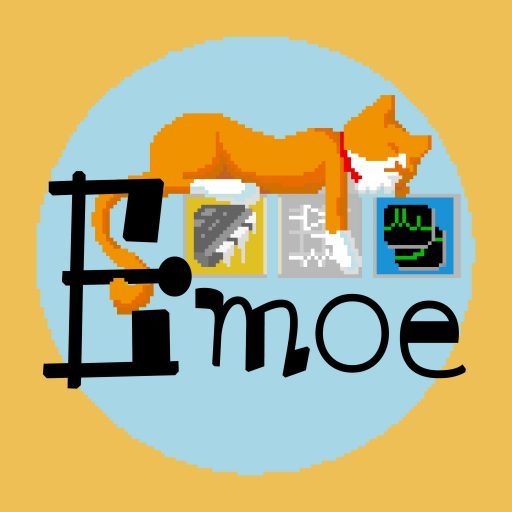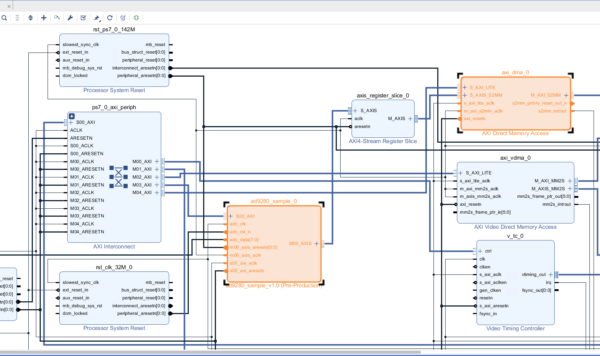本文由Motto撰稿于2025年5月31日。Small-U代为投稿
音源效果
如下是音源通过AG03声卡内录的效果(点击下载mp3文件)
FM音乐背景
曾经有人找到笔者想要利用YM2151芯片制作类似Yamaha DX7一样的电子琴,那时我还对调频(FM)电子音乐没有什么概念。但是其实这种风格的音乐已经陪伴了80后90后的前20年时光,一些经典音乐比如《云宫讯音》、《爱如潮水》都以DX7的音色为特征。
有关FM音乐和DX7的描述,可以参考如下视频:
FM音乐的原理
FM音乐作为上世纪80年代介于PWM蜂鸣器和全采样音频之间的技术,它是如何产生声音的呢?
众所周知,自然界最本征的声音,便是正弦波单频信号。于是,FM频率调制的基础信号,便是来自正弦波表(当然也可以用其他的波表,但是这样子谐波就不太好控制了)。除了频率之外,我们对声音的感受还包括了包络信息,那么我们可以生成这样的一个基础信号:
y(t) = E_y(t) \cdot \sin(2\pi f_y t)其中,E_y(t)是y(t)的包络信号,可以由Attack、Decay、Sustain和Release四个阶段描述;f_y是y(t)的频率。我们将这个信号再次进行一次调制,就可以得到一种FM音频信号:
z(t) = E_z(t) \cdot \sin[2\pi f_z t + y(t)]我们可以把f_z叫做载波频率,把f_y叫做调制频率。载波频率决定了声音的高低,而调制频率和载波、调制的包络决定了音色。可以看到,生成上述的一种FM信号需要查询2次正弦表,乘2次包络信号;于是正弦波表、包络发生器、乘法器,以及时分复用的电路就构成了FM合成器的核心组件。而在FM合成术语中,我们把一次正弦查表乘以一次包络叫做一个算子;显然上述FM合成的例子包括了两个算子,由调相级联起来。
YM2151
上述的音乐合成概念,最早由John Chowning于20世纪60年代提出,那时候计算机性能受限,无法实时生成音色丰富的音乐。于是这个概念在AC’97规范提出之前很受欢迎,一些经典的街机、电子琴和电脑都采用了FM合成技术,而雅马哈则在80、90年代垄断了FM合成器的市场。
YM2151作为雅马哈FM合成器系列的一种,代号为OPM,于1984年推出。它包含了4个算子,并支持8种算子级联方式(又叫做算法),如下图所示。它除了FM算子之外,还包含了一个低频振荡器。它的四个算子(事实上为一个正弦表复用4次)被时分复用为8个声道,而8号声道的第4个算子又可以被配置为噪声源。

YM2151的数据手册可以参考这里。我将常用的寄存器配置整理成了如下的图片。
YM2151音符发生器:

YM2151算子:

YM2151包络发生器:

YM2151低频振荡器:

音源制作过程
之前已经有很多人使用YM2151制作音源了,这个项目很多都是参考Gasshi的SPFM Light硬件和SCCI 1.0上位机。
硬件
SPFM Light的硬件包括两大部分:主板和音源扩展板。本项目将两部分合并,使用RP2040作为YM2151的主控,通过解析SCCI 1.0协议,将上位机的寄存器dump的VGM音乐发送到YM2151。
PCB原理图
原理图如下所示,包括主控引脚的引出、YM2151和DAC的连接。我直接采用RP2040的4MHz PWM输出作为YM2151的时钟,节省了一个晶振。
RP2040 Pico板子的引脚引出:

YM2151和DAC的连接:

USB供电滤波器:

PCB电路图
原理图做好之后,我先是用洞洞板验证了一下(程序附在文章末尾),然后再用KiCad绘制PCB,引脚顺序经过调整来方便布局。主要走线在板子底面,正面只有几个电源跳线,这样子方便做洞洞板。

制作过程中DAC封装画错了,掰引脚修改的途中断了两个脚,只好飞线解决。

外壳
外壳使用FreeCad制作,通过对PCB的Step文件创建Datum对象来获得需要参考的板子特征。这样子就可以处理接口的预留空间、板子的对齐孔和安装卡扣。

成品
外壳使用3D打印制作;亚克力顶盖最后加上了激光雕刻的文字,并用丙烯颜料涂色。最终使用AB胶对音频座和飞线部位加固。

上位机
到此硬件的部分描述完毕,软件也有很多前辈做了不少工作,比如本项目使用到的MDPlayer和SCCI。
MDPlayer和SCCI
MDPlayer是一款VGM播放器,可以读取VGM音乐,并且内置了大量的软音源用来播放。SCCI是SPFM Light硬件的上位机,通过DLL挂载到MDPlayer。这样子硬音源就可以播放YM2151的VGM音乐了。
SCCI 1.0 协议
关于SCCI协议的描述,可以参考这个文档,它的大致原理如下:
- 初始化
- 串口波特率1500000,8位,1停止位,无校验,无流控制。
- 上位机发送0xFF,SPFM Light收到0xFF之后,返回’L”T’2个字节,告诉上位机连接的硬件是SPFM Light。
- 上位机发送0xFE,SPFM Light收到0xFE之后,对YM2151复位,然后返回’O”K’2个字节。
- VGM数据发送
- 上位机发送如下几种可能的命令
- 0x0[slot] – 0x0[a] – 0x[Addr] – 0x[Data];这表示向第[slot]插槽的[a]脚选择的芯片的[Addr]寄存器发送[Data]数据。
- 0x0[slot] – 0x8[a] – 0x[BusData];这表示向第[slot]插槽的[a]脚选择的芯片的总线发送[BusData]数据。
- 0x0[slot] – 0x20 – 0x[BusData];这表示向第[slot]插槽的SN76489芯片发送[BusData]数据。
- 上位机发送如下几种可能的命令
上位机的运行
- 安装MDPlayer的STL449版本,这是MDPlayer最后一个支持SCCI 1.0的版本。
- 将SCCI压缩包的dll和配置程序解压到MDPLayer的根目录下。
- 连接硬音源,打开scciconfig.exe,此时应该能够检测到SPFM Light硬件,并将slot 0设置成YM2151,时钟为4MHz,然后关闭配置程序。
- 打开MDPlayer,在设置的Sound页面中的YM2151框架中选择Real并勾选4MHz时钟。
- 在VGMRips中选择YM2151对应的VGM音乐,下载下来使用MDPLayer播放。
SPFM固件
基于上述SCCI 1.0协议,我们可以写出如下RP2040 Arduino程序。
/*
Copyright (C) 2025 Motto (https://x.com/YangMotto)
This program is free software: you can redistribute it and/or modify
it under the terms of the GNU General Public License as published by
the Free Software Foundation, either version 3 of the License, or
(at your option) any later version.
This program is distributed in the hope that it will be useful,
but WITHOUT ANY WARRANTY; without even the implied warranty of
MERCHANTABILITY or FITNESS FOR A PARTICULAR PURPOSE. See the
GNU General Public License for more details.
You should have received a copy of the GNU General Public License
along with this program. If not, see 可能的后续工作
- 尝试雅马哈的其他FM芯片。
- 板子上附加2片SN76489,丰富一下节奏和PWM伴奏。




![仪表博物馆[01] — Tektronix 2465](https://www.emoe.xyz/wp-content/uploads/2019/10/IMG_7496-600x400.jpg)